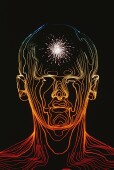Antiepileptic drug therapy recommended to help stave off recurrence
TUESDAY, April 21, 2015 (HealthDay News) — One in 10 people worldwide will have a seizure in their lifetime, experts say. Now, two medical groups have issued a new guideline on how to treat them. The guideline, published in the April 21 issue of Neurology, will be presented this week at the annual meeting of the American Academy of Neurology, held from April 18 to 25 in Washington, D.C.
The decision to treat a patient after a first seizure is complex because physicians must weigh the risks and benefits on an individual basis, according to the American Academy of Neurology and the American Epilepsy Society. After a review of all available evidence, the two organizations concluded that administering an antiepileptic drug immediately after a first unprovoked seizure may reduce the risk of more seizures.
“This is a valuable new guideline that could change the approach many doctors take to treating a first seizure and could improve patients’ lives,” guideline coauthor Allan Krumholz, M.D., of the University of Maryland School of Medicine in Baltimore, said in an academy news release. “About 150,000 adults have an unprovoked first seizure in the United States each year. Even one seizure is traumatic and affects a person’s life in many social ways, such as driving a car, employment options, falling risks, and the fear of having another seizure in public. This guideline clarifies when risk factors put individuals at greater risk,” Krumholz said.
Adults who have an unprovoked first seizure are at greatest risk for another seizure within two years. The risk varies from 21 to 45 percent, according to the guideline. In addition, there was strong evidence that the risk of a second seizure is highest in people with a previous brain insult — such as stroke, brain tumor, or head injury — and in those with an electroencephalogram test result that shows signs of epilepsy.
Copyright © 2015 HealthDay. All rights reserved.








